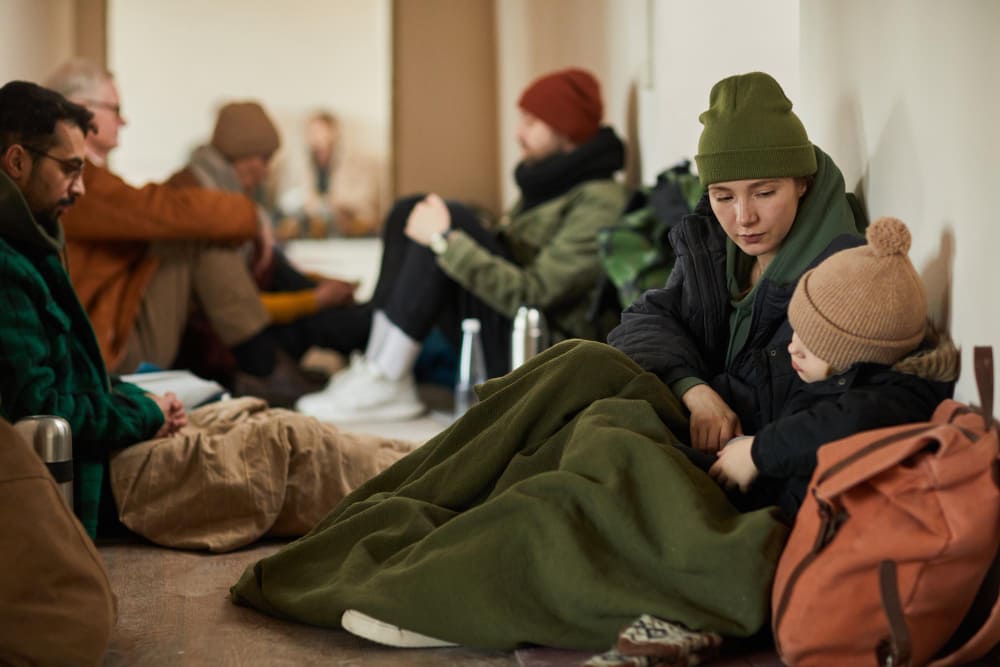
According to the United Nations High Commissioner for Refugees, a ‘refugee’ is an individual fleeing their country of nationality due to war, violence, conflict, and/or persecution, in an attempt to seek safety and protection elsewhere.
In Canada, Refugee Law is largely guided by the Immigration and Refugee Protection Act 2001 (IRPA) and jurisprudence of the Federal Court of Canada. This legislation further details, under s.96, the eligibility requirements of a Convention Refugee; namely, “a person who, by reason of a well-founded fear of persecution for reasons of race, religion, nationality, membership in a particular social group or political opinion” is unable or unwilling to seek protection or return to their country (or countries) of nationality due to fear.
Under s.97 of the IRPA, a Convention Refugee is in need of protection if they fear persecution in their country/countries of nationality and if they believe, on substantial grounds, that they will be subjected to a risk of cruel and unusual treatment or a risk to life in the event of returning to their country. Hence, sections 96 and 97 of the IRPA are fundamental to refugee protection claims in Canada and are thus relied upon accordingly. Moving forward, this article lays out the process of claiming refugee protection in Canada.
There are a number of actors involved in the refugee claim process, namely: the Immigration and Refugee Board of Canada (IRB), Immigration, Refugee and Citizenship Canada, (IRCC), and the Canadian Border Services Agency (CBSA). The three play distinct roles within the process. For instance, the IRB is Canada’s largest decision-maker when it comes to refugee and immigration matters. The IRCC ultimately determines the eligibility of refugee protection claims and the CBSA is responsible for the enforcement of refugee and immigration functions such as detentions, removals, investigations, and intelligence.
As it pertains to refugee claims specifically, there are two Board levels at play: the Refugee Protection Division (RPD) and the Refugee Appeal Division (RAD). The RPD is the first to hear and determine refugee protection claims in Canada, if rejected, the RAD then hears appeals from the RPD decision and is tasked with determining whether to allow or reject the refugee protection claim; or alternatively, may send back the claim for re-determination to the RPD.
At the outset, there are three main reasons why an individual may be inadmissible to claim refugee protection in Canada. First, a person with Canadian citizenship or Permanent Residency (PR) is ineligible, for discernible reasons. Second, individuals who have applied for Refugee Protection in Canada or elsewhere previously. Third, individuals with a history of serious criminality or crimes against humanity or human rights violations; in seeking to protect public safety.
If found to be inadmissible to claim refugee protection, for any given reason, there are alternatives that claimants may turn to, such as a Pre-Removal Risk Assessment Application (PRRA), where a claimant is given the opportunity to explain why they are afraid to go back to their country and why they must stay in Canada.
Otherwise, claimants may resort to an Application for Judicial Review (JR), where a judge will review the lawfulness of the decision in question. Nevertheless, the intricacies of these alternative processes are beyond the scope of this article.

Refugee protection claims are required to be made from within Canada. There are two ways to claim refugee protection in Canada; the first is to claim upon arrival at the Port of Entry (POE), and the second is via the online Refugee Portal after arrival (Inland). The process for each varies slightly in its steps but are ultimately the same in purpose.
A POE claim is made at the port of entry, this means that upon arrival, either at the airport or at the land border, an individual declares to the CBSA officer that he/she/they are seeking to claim refugee protection in Canada. Those seeking to claim protection in this manner will be questioned by the CBSA officer to determine the reason for making the claim. The claimant will then be given a deadline by CBSA – typically 30 days – to submit the refugee protection application forms and to return for an eligibility interview on a scheduled date and time.
Refugee Claimants are expected to submit the following forms by their assigned deadline: Generic Application Form, Schedule A, Schedule 12, Use of Representative, and a Basis of Claim. The Generic Application, Schedule A, Schedule 12 forms require Claimants to fill out information regarding their personal contact and identification details, dependants’ information, identity document information, travel, criminal, residence, and personal histories, among other details.
The Use of Representative is a document signed by the claimant/s and the representative (legal counsel), which indicates who will represents the Claimant/s, legally. Claimants are given 30 days to submit the above documents, upon which they will typically be scheduled for an admissibility interview with CBSA to ensure eligibility is met.
Once determined to be eligible, Claimants are typically given 15 days (due to Covid-19, this is now 45 days) to submit the last form, namely the Basis of Claim (BOC). The BOC sets out the Claimant’s reason/s for seeking refugee protection in Canada. It is at this stage where the Claimant/s are given the opportunity to submit a well-drafted narrative account of their personal background and reasons for fleeing their country (or countries) of nationality.
The narrative is a fundamental piece of the refugee protection claim. Claimants are expected to provide a clear and detailed story of their personal history and a recounting of the event, or series of events, that lead them to flee their country and seek safety in Canada – and the reason why they are unable or unwilling to return to their country. Claimants are strongly encouraged to share as many details as possible in their narrative, given that this will exhibit further credibility within their claim, which in turn establishes a stronger case before the IRB.
Alternatively, Refugee Claimants can submit claims after having entered Canada. There are several factors that may play into a Claimant’s inability or unwillingness to claim immediately upon arrival at the port of entry; this does not undermine the claim, so long as the reason/s are laid out and explained within the Claimant’s narrative. When it comes to Inland claims, this process is carried out via the IRCC Online Refugee Portal, rather than in person. In such, Claimants are given 90 days, from the date in which they opened/created their portal account, to submit their refugee protection claim.
The process is distinct from a POE claim, in the sense that Inland Claimants are not required to submit the aforementioned POE forms but are, in turn, expected to fill out the same information within the portal. Once this information has been filled out, the portal will prompt the Claimant to upload a copy of their passport or other identity documents, a copy of a Use of Representative (signed by the Claimant/s and the legal representative), a BOC (including a detailed narrative), as well as any additional documents or evidence that the Claimant would like to include as part of the claim at this stage.
Once the claim has been submitted, either in person or online, the Claimant is expected to check their emails (and/or portal account) regularly for any communication or notices received regarding the status or the next steps in their refugee claim process (future appointments, notices, hearing dates, etc.) – unfortunately, the current wait time for scheduled hearing dates cannot be anticipated with certainty.
Once found to be admissible to claim refugee protection based on the above criteria, and having submitted all the required information and documentation necessary within the POE or Inland claim, Claimants are encouraged to gather and provide the following evidence for their prospective hearing:
Note: All supporting documents must be sent at least 10 days prior to the hearing. All documents must be legitimate, dates must correlate with the events described in the narrative, and the documents must be submitted in either one of Canada’s official languages, English or French (translation is required otherwise).
Claimants (particularly their counsel or legal representative) are allowed to submit up to 100 pages of disclosing articles, reports, and National Documentation Package (NDP) documents outlining objective country conditions. In other words, publicly accessible documents that will help support the claims and/or accounts of hardship and fear of persecution that the claimant has pointed to in their narrative.
When it comes to refugee protection claims, there typically are no judges involved in the process, instead, the hearing takes place at the Refugee Protection Division before a Board Member (BM). Once the Claimant has received an appointment for their hearing, they will be required to attend on the date and time set out.
The hearing takes place at the Refugee Protection Division (RPD) – currently, in a virtual setting. Claimants are expected to be prepare for the hearing 15 minutes prior to the scheduled time. At the hearing, Claimants are questioned regarding the narrative and evidence submitted in support of their claim in order to determine, whether they are legally entitled to receive refugee protection status in Canada or not.
There are three possible outcomes that a claimant will be given from the Board Member in deciding the matter, either:

In the event that a claim be rejected at the RPD level, Claimants have the opportunity to appeal the decision to the Refugee Appeal Division (RAD), which is separate and independent from the RPD. The appeal is an opportunity for the Claimants to ask a higher-level tribunal to review the decision made by a lower-level tribunal, in hopes of determining that there has been a mistake of law, fact, or both, in the RPD decision.
At this stage, Claimants are allowed to present new evidence, but only such evidence which was not available to the Claimant at the time of the RPD hearing or evidence that could not reasonable have been accessible at the time. An oral hearing may be required to consider new evidence, if applicable.
Nevertheless, the IRB outlines circumstances in which Claimants are ineligible to appeal a negative RPD decision, such as:
Source: https://irb.gc.ca/en/refugee-appeals/Pages/RefAppGuide.aspx#s2.05
As outlined in the IRB Appellant’s Guide, Appellants (representatives) are required to file a notice of appeal within 15 days of receiving the RPD decision, if they wish to appeal the decision. After which, Appellants (representatives) are then expected to submit the appellant record (including a Memorandum of Arguments), no more than 45 days after receiving the RPD decision. Once the Claimant has appealed the negative RPD decision to the RAD, unless a hearing is ordered, the RAD will provide its decision 15 days after the appellant record is submitted.
Claiming refuge protection in Canada can seem quite intricate and complex. This article sought to share a glimpse of what the process will typically look like, but the fact of the matter is that there are number of factors and circumstances, relevant to each Claimant, that may vary the steps or outcomes of the process. To receive more tailored or personalized advice, you are highly encouraged to seek legal representation.

